|
|

Barnacles
Barnacles are most unusual animals. They are arthropods, in the same major group as insects and spiders, and are most closely related to decapod crabs, prawns, lobsters and yabbies.
Unlike most of their relations, barnacles are usually fixed to a rocky surface. The larvae go through several distinct swimming stages as plankton, before settling into place onto a rock. The juveniles pick their place to settle because they can detect their adults by chemical means.

Adult rock barnacles are protected by four, six or eight calcareous plates, which form a volcano-like cover. The top entrance is covered by another two plates.
When feeding, these two top plates open and basket-like cirri limbs wave into the oncoming current of water and direct food into the mouth.
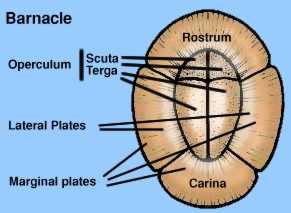
Barnacle Reproduction and Life Cycle
Barnacles do not release their gametes into the sea, but are able to fertilise one another. Barnacles are hermaphrodytic, which means that a single animal has both male and female parts.
When ready to reproduce, an adult barnacle uncoils its long tubular penis and extends it out through the operculum to search for a nearby receptive neighbour. When the sperm is transferred, the fertilised eggs are brooded within the shell of the receiver adult until they develop into a nauplius larvae. A single adult barnacle may release over 10,000 larvae.
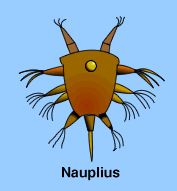 The
numerous naupli are then released
into the water as plankton.
A nauplius is obviously a crustacean, since it has a antennae, an eye
spot, jointed appendages and a shield-shaped body, Can you name the body
parts?
The
numerous naupli are then released
into the water as plankton.
A nauplius is obviously a crustacean, since it has a antennae, an eye
spot, jointed appendages and a shield-shaped body, Can you name the body
parts?
As the nauplius grows and develops it goes through several moult stages, until it reaches the cyprid larvae stage.
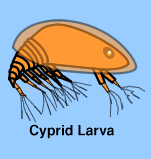 Now
it does not feed. Its body is contained within a hinged carapace,
and now it has large antennae, and more appendages. Cyprids have chemical
and touch detectors that can recognise adults of its own species and suitable
rocky environments. When everything is right, the cyprid larvae uses special
cement glands in its antennae to attach itself to the rock.
Now
it does not feed. Its body is contained within a hinged carapace,
and now it has large antennae, and more appendages. Cyprids have chemical
and touch detectors that can recognise adults of its own species and suitable
rocky environments. When everything is right, the cyprid larvae uses special
cement glands in its antennae to attach itself to the rock.
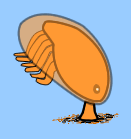 The
cyprid then moults and rotates its body so that the appendages now face
upward. They now modify to form long and feathery cirripeds
(cirri, plural) which sweep through the water for planktonic food. The
cyprid carapace is a structure around which the barnacle secretes its
fixed shell plates as walls, and the four moveable plates on top, which
open to allow the cirri to gather food.
The
cyprid then moults and rotates its body so that the appendages now face
upward. They now modify to form long and feathery cirripeds
(cirri, plural) which sweep through the water for planktonic food. The
cyprid carapace is a structure around which the barnacle secretes its
fixed shell plates as walls, and the four moveable plates on top, which
open to allow the cirri to gather food.
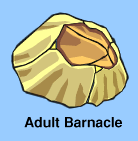 Now
the barnacle will live out its life living inside its "house"
firmly attached to one spot on the rock. It cannot move about and is dependent
upon the high tides to bring all the things that it needs to survive.
Interestingly, many species of barnacle live quite high on the shore and
may only be covered with water for only a few hours each day. For the
rest of the time they must endure the baking sun.
Now
the barnacle will live out its life living inside its "house"
firmly attached to one spot on the rock. It cannot move about and is dependent
upon the high tides to bring all the things that it needs to survive.
Interestingly, many species of barnacle live quite high on the shore and
may only be covered with water for only a few hours each day. For the
rest of the time they must endure the baking sun.
A most unusual Barnacle which does not construct a shell-like covering is the parasitic barnacle. It takes residence under the abdominal flap of a small shore crab, the Smooth-handed Crab, Pilumnopeus serratifrons. Because of the activities of the parasitic barnacle, which feeds off the living tissues of the crab, the male crab is castrated, and adopts a female-like form.
Some examples of barnacles as we move from high tide level down to the low-fringe level in the Eastern Warm Temperate Zone of south-eastern Australian rocky ocean shores are:
![]() Honeycomb
Barnacle, Chamaesipho tasmanica.
Honeycomb
Barnacle, Chamaesipho tasmanica.
The Honeycomb Barnacle often forms a dense cover of hundreds, or even
thousands of barnacles over rock surfaces on exposed shores at mid- to
high-tide levels.
![]() Six-plated
Barnacle, Chthamalus antennatus.
Six-plated
Barnacle, Chthamalus antennatus.
The Six-plated Barnacle lives so high on the shore that it might only
be covered by the tide for only a few times each month to feed. How it
it possible for this barnacle to live at these high shore levels?
![]() Rosette
Barnacle, Tetraclitella purpurascens.
Rosette
Barnacle, Tetraclitella purpurascens.
The Rosette Barnacle may also be found at quite high levels, usually under
shelter behind boulders or in gutters away from the full force of the
waves. It is a shade preferring barnacle.
![]() Rose-coloured
Barnacle, Tesseropora rosea.
Rose-coloured
Barnacle, Tesseropora rosea.
The Rose-coloured Barnacle may be found at mid- to high-tide levels,
but it prefers to live on the exposed rock surface, facing the waves where
wave action is moderate to strong.
![]() Surf
Barnacle, Catophragmus polymerus.
Surf
Barnacle, Catophragmus polymerus.
The Surf Barnacle also prefers rock surfaces exposed to high energy waves.
It prefers regions which are fairly low on the shore, near the Galeolaria
zone.
![]() Giant
Rock Barnacle, Balanus nigrescens.
Giant
Rock Barnacle, Balanus nigrescens.
The Giant Rock Barnacle is found at and below low tide level, preferring
vertical rock surfaces that are pounded by medium to strong waves.
In fact, in south-eastern Australia, the barnacles shown above are so specific to a particular location or level on the shore, they are particularly good indicator species of a certain tidal level.
Click here to see where Barnacles live on a Boulder Shore.
| For more information on Crustaceans visit MESA Crustaceans |
References
Bennett, I. (1987) W. J. Dakin's classic study: Australian Seashores. Angus & Robertson, Sydney.
Davey, K. (1998) A Photographic Guide to Seashore Life of Australia. New Holland, Sydney.
Edgar, G. J. (1997) Australian Marine Life: the plants and animals of temperate waters. Reed Books, Kew.
Jones, D. & Morgan, G. (1994) A Field Guide to Crustaceans of Australian Waters. Reed, Chatswood.
Quinn, G. P., Wescott, G. C. & Synnot, R. N. (1992) Life on the Rocky Shores of South-eastern Australia: an illustrated field guide. Victorian National Parks Association, Melbourne.
Marine Research Group of Victoria (1984) Coastal Invertebrates of Victoria: an atlas of selected species. Museum of Victoria, Melbourne.
Neilsen, T. M. (1982) The Marine Biology Colouring Book. Barnes & Noble Books, New York.
Underwood, A. J. & Chapman, M. G. (1993) Seashores: a beachcomber's guide. New South Wales University Press, Sydney.
Surf
Barnacle
Six-plated Barnacle
Honeycomb Barnacle
Rose-coloured Barnacle
Rosette Barnacle
Giant Rock Barnacle
Home
Page
Taxonomy
Biogeography
Rocky Shores
Tidal Levels
Intertidal Zonation
Environmental Factors
Biological
Factors
Feeding Relationships
Activities
Glossary
References
 Life
on Australian Seashores
Life
on Australian Seashores
by Keith Davey (C) 2000
Learning Consultant
- Media
The University of Newcastle
email at australian_seashores@hotmail.com
Scientific Consultant: Phil
Colman
site created 01.01.98 : updated 01.04.2000